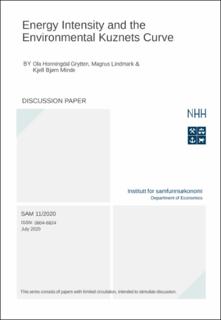Energy Intensity and the Environmental Kuznets Curve
Working paper

Åpne
Permanent lenke
https://hdl.handle.net/11250/2670847Utgivelsesdato
2020-07Metadata
Vis full innførselSamlinger
- Discussion papers (SAM) [657]
Sammendrag
During the last decades several scholars have argued that environmental degradation first increases in initial phases of economic growth, and thereafter declines as economic growth enters a certain level in developed economies. This makes environmental degradation form an inverse U-shaped curve, called the environmental Kuznets curve (EKC). Environmental degradation can be measured by different proxies. This paper deals with two, i.e. energy consumption and energy intensity (EI), which again is measured as the ratio between energy consumption and GDP. The relationship of energy consumption and energy intensity to economic growth can thus, serve as tools to examine whether an EKC exists.
Hence, this paper presents continuous series of energy consumption, energy intensity and gross domestic product for the Norwegian mainland economy 1835-2019. These are thereafter utilized in order to examine the possible existence of relative and absolute environmental Kuznets curves (EKC).
The time series are established by drawing on available data, and annual figures for the period 1835-2019 are presented for the first time. They depict a development which reflect that EKCs exist. The paper also offers a polynomial regression model to investigate into the relationship between environmental degradation, measured by energy consumption, energy intensity and economic growth expressed as GDP per capita. It concludes there is clear evidence of both relative and an absolute EKC-relations between environmental degradation and economic growth, with 1975 as relative and 2002 as absolute turning points.